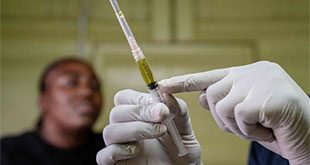The politics of peacekeeper memorials
The erection of the “Memorial Wall of Our Heroes” in the AU’s headquarters in 2018 was an interesting development. It lists the names and ranks (but no dates) of peacekeepers who have died on AU-mandated peace support operations (such as AMIB, AMIS, AMISOM, MISCA) and AU-authorised peace operations (such as the MNJTF and G5 Sahel Joint Force). However, shortly after its erection, the wall was covered in black drapes that concealed the names of the fallen heroes. The drapes were removed the following year when the memorial wall was officially inaugurated on May 25, 2019. As of August 2019, there were 1,108 names listed on the wall in nineteen columns.
As for AMISOM, it too has a memorial for its fallen personnel just outside its force headquarters in Mogadishu. However, it lists no names or numbers. Rather, its dedication reads: “In memory of the officers, men and women of the African Union Mission in Somalia (AMISOM), and the Somali National Security Forces (SNSF), who lost their lives in pursuit of peace and stability in Somalia.”
So What?
What does this new information mean for an attempt to provide an overall estimate of AMISOM’s fatalities? In sum, there is now a reasonably plausible set of estimates for almost the entire period of AMISOM’s deployment between March 2007 and December 2018 derived from five sources.
First, in my book, I cite an internal AMISOM briefing presentation given to bilateral partners on February 25, 2009 which stated that AMISOM had suffered 12 fatalities and 25 injured peacekeepers as of December 10, 2008. I assume this is accurate since it was provided discretely by the AU to AMISOM’s bilateral partners; the numbers are low enough that at that stage the issue was not considered especially controversial; and it reflects the fact that AMISOM engaged in relatively little fighting during 2007 and 2008.
A second relevant source is the new Peacemakers at Risk dataset produced out of the Uppsala Conflict Data Program. For 2009, this estimates 40 AMISOM peacekeepers were killed in violent attacks. My research suggests that another six AMISOM peacekeepers died in 2009 (four from illness and two from motor vehicle accidents), making a total of 46.
A third source is the financial records between August 2009 and September 2012 discussed above, which revealed 439 AMISOM fatalities. Twenty-two of those occurred between August and December 2009. This leaves 417 between January 2010 and September 2012.
Fourth, the publicly released AU financial reports provide information about compensation payments that could plausibly suggest that AMISOM suffered approximately 1,148 or 747 fatalities between 2014 and 2018 (depending on whether one assumes a 79:21 or 50:50 ratio of death and disability compensation payments).
Fifth, the SIPRI database on multilateral peace operations—which collected data on AMISOM’s fatalities between 2009 and 2014—received a figure of 261 fatalities from AMISOM officials for the 2013 calendar year.
Taken together, these sources cover most of AMISOM’s timeline, although they leave some periods unaccounted for, namely, December 11–31, 2008 and October to December 2012. However, these periods represent only 3.5 months out of the 141 months from March 2007 to December 2018, or 2.5 percent of AMISOM’s deployment time.
In sum, previous research combined with the newly released AU financial data and the Peacemakers at Risk dataset suggest that a plausible estimate of AMISOM’s fatalities between March 2007 and December 2018 could be between 1,483 and 1,884 (see Figure 4). Based on the above analysis, it is likely that the real number is closer to the higher end of this range than the lower end. Finally, there is a high likelihood that AMISOM suffered additional fatalities during the 3.5 months currently missing from the data.
****
Paul D. Williams is Professor in the Elliott School of International Affairs at the George Washington University. He tweets @PDWilliamsGWU.
 The Independent Uganda: You get the Truth we Pay the Price
The Independent Uganda: You get the Truth we Pay the Price





